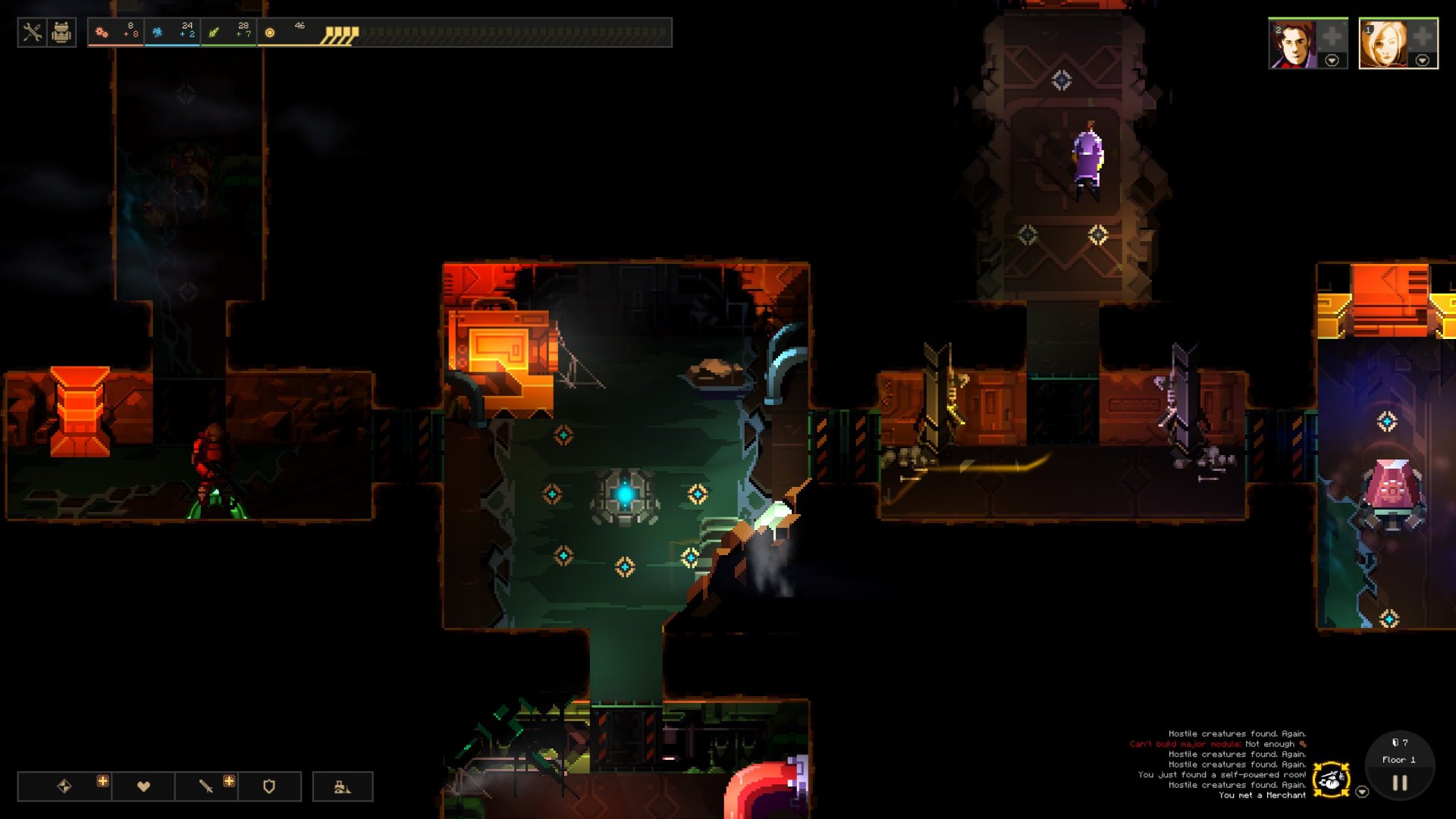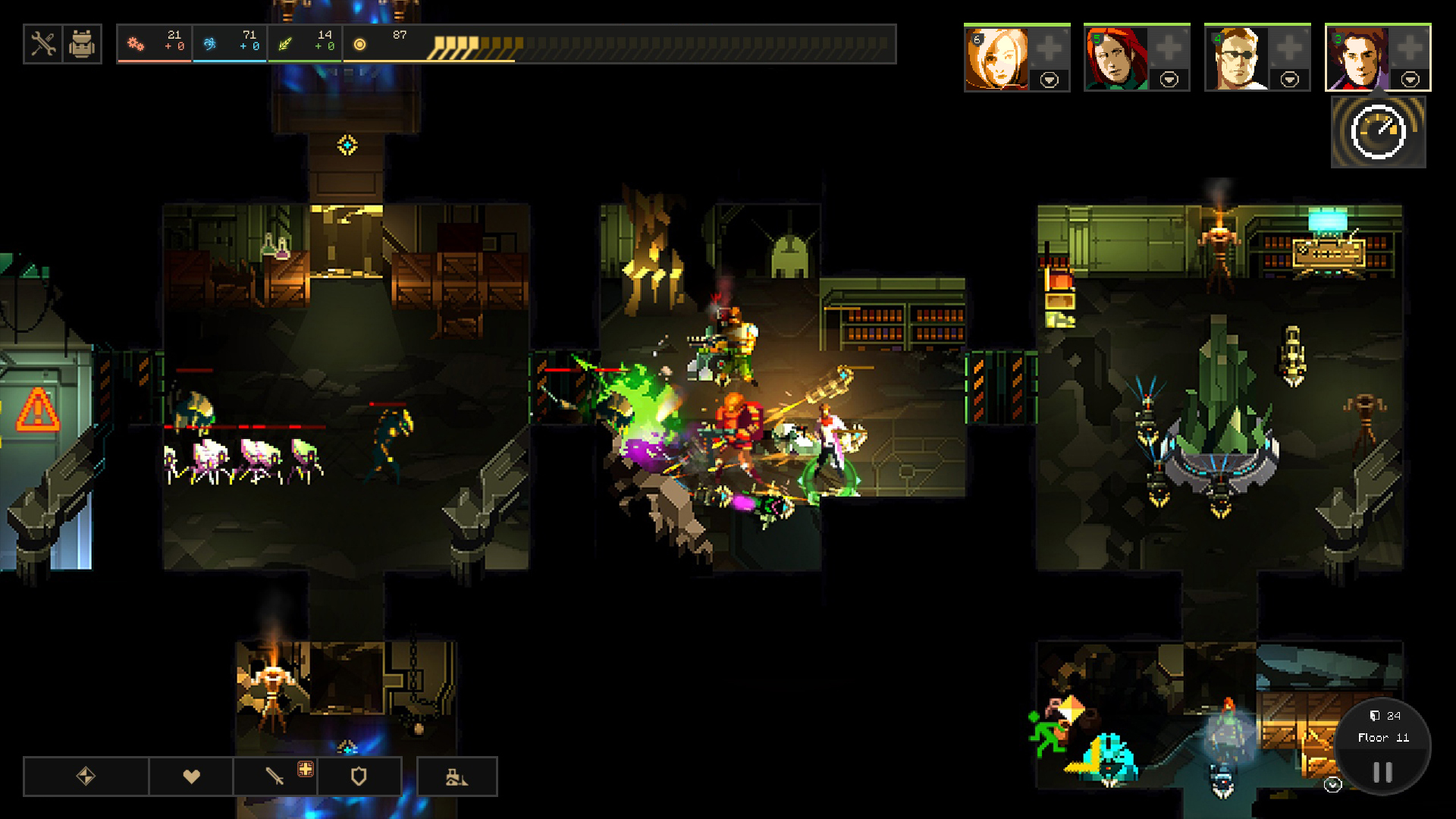

A lot of games today tend to mix genres, it’s rare to see a straight shooter with no RPG elements or an RTS that doesn’t also utilize some elements of tower defense. But what is rare today is to find a game that does it so seamlessly and well that it almost creates a new genre in itself. It’s because of this, Dungeon of the Endless from Amplitude Studios’ Games2gether team is one of the freshest games I’ve played in years.
Dungeon of the Endless blends so many genres together that it’s difficult to describe exactly what type of game it is. At its core, it is a rogue-like, which means each time you play it’s a randomized set of levels and it’s "game over" should you die. It’s also a tower defense game, where rooms can have set upgrades placed to take care of baddies that spawn within the floor itself. On top of all this, the actual game runs through a mixture of turn-based plays, with each turn defined as opening a new door in the dungeon, and real-time action as you move between rooms and battle foes. There’s also a splash of RPG elements as you can level up characters, unlock new abilities, and discover or purchase new equipment with which you can customize your character.

All of these systems work together seamlessly to play like something that feels close to a cooperative board game. You start out on the first floor, with your ship crashing into a planet, and its your job to find the exit all the way up (or is it down) on the 13th floor. Each level more or less plays out the same: open doors until you find the exit, then take the power crystal from the start to the exit all the while fending off the denizens of the dark. The catch is that once you grab the crystal, the entire level opens up and quickly fills with monsters making the journey a perilous one.
As you move from room-to-room, you’re faced with a decision to make: do you provide power to the room or do you leave it in darkness? If the room is powered, you’ll be able to build a resource generator and modules to help fend off foes. Enemies also won’t spawn in rooms that are powered, which helps keep you that much safer when you open doors or finally pick up the crystal. The catch is that you only have so much of the "light" resource available to use to power rooms. To make matters more difficult, should the enemies get to your crystal and start attacking it, you lose some of that resource. While there are a lot of different elements brought into Dungeon of the Endless, the driving factor to the game is resource management. Do you save up all of your resources on one level so you have more for the next, or do you spend them all? Should you spend some of the "light" resource to power up a nearby room just to prevent enemies from spawning there, or do you have one of the characters stand it (which also prevents monster spawns) while the next door is opened?

Aside from the "light" resource, resources come in three flavors - industry, science and food. Industry is used primarily to build the modules, science is used to research module upgrades, and food is used to heal and level up your character. All of these resources also have other uses. For instance, some shop keepers will let you buy gear using the science resource, or new characters can be recruited with food. Every time you open a door you’ll gain more resources based on what’s in the level and what modules you’ve placed down. If playing the game alone, you’ll get all the resources. In co-op, the amount of resources each player gets is split amongst all the players, but they aren’t shared, so players can decide amongst themselves who should spend industry resources to build a generator though you can gift them between players.
Co-Op play is where Dungeon of the Endless shines. It’s such a social experience; like a bunch of friends sitting around a coffee table talking about what careful action to take next. Every pro and con should be weighed amongst the party, deciding just what door to open, who will specialize in building equipment, and which players will be in what rooms when the waves start spawning. There are a lot of systems at play here and players must come up with some really clever strategies to beat the odds as well as make some tough trade-offs at almost every turn. This all starts with choosing what characters to bring along.
There’s a strategy in what characters are utilized where in your dungeon layout. Perhaps one hero has a passive ability that increases a major module’s resource generation for them, so he or she stays behind to get more industry in order to be the module builder later in the level. Maybe another character is better off at fighting in a room without any allies around, so they stay behind at a critical point to help defend against enemies going after the crystal. Other characters give buffs to the entire team in the same room so they’re best suited as the "exploration" team that’s opening doors and fighting off the threats that reside within. All characters have active abilities that can turn the tide of battle when things get hectic - and they will get hectic.
When a player inevitably dies, he or she loses an active role in the level. While he or she can still see the action and still earns resources for every door opened, the player can’t join back in until a new recruit is found and purchased for them to take over. That said, the player can still gift resources, create defenses, and help with the overall strategy.
As this is a rogue-like, one poor decision can mean the end of your entire team. Opening doors is a dangerous action in Dungeon of the Endless because it not only gives you resources, but gives a chance to spawn monsters in all rooms where there aren’t any players or power. That means the more doors that are open and the more rooms that are left unpowered, the more monsters that can potentially spawn and wipe out your party and/or crystal.
Dungeon of the Endless is one of the best co-op games we’ve played this year. Its fresh set of ideas, careful blending of genres, and replayability make it incredibly addictive and of course, incredibly fun. The pacing of the game makes it ideal for co-op sessions, though, you might find yourselves investing hours of time to finish a run to floor 13. With endless possibilities on every level and behind each new door, there’s no reason to shy away from this outstanding co-op adventure.
Additional editing on this review was done by Jason Love.